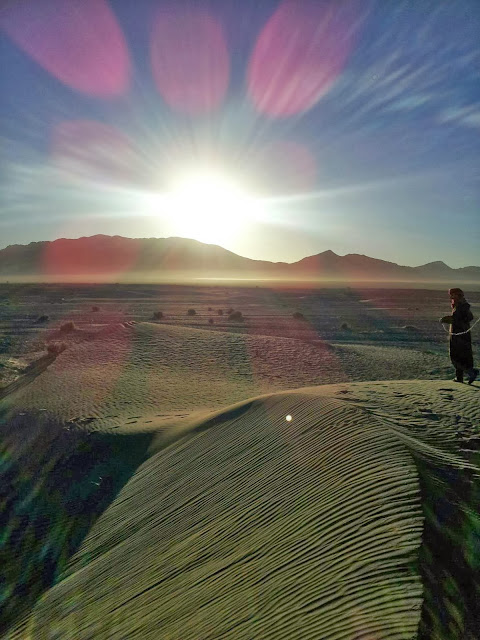John Gans offers a unique perspective. He obtained his master's at SAIS, starting in Bologna and then moving to DC, and now is pursuing his PhD from SAIS, splitting time between Washington and Bologna. Before moving back this month to the U.S., John shared some thoughts on his experiences at SAIS.
Q: How did you first learn about SAIS, and how did you end up at SAIS?
Gans: On the application for the SAIS MA there was a box that said something like: “Do you want to go to Bologna or DC or be considered for both?” I checked “both.” In 2007, I had no idea that SAIS had a campus in Italy, which was more a reflection of my poor research than SAIS’s promotion, and no intention of going to it, which was a reflection of my strong DC-focus. But I figured consideration from both campuses would improve my odds of getting in somewhere. It was a fateful choice, but like so many, it did not turn out as expected.
 |
Gans (L) sharing his thoughts with
MA candidate Michael St. Germain |
Q: You studied for your master’s in Bologna and then in DC. Why did you decide to do that? Was it a good decision?
Gans: The decision was a great one, but it was not entirely mine. I was accepted into the 2007-08 SAIS Europe class. As I lived three blocks from the Washington campus and thought two years in DC made better sense for my life, I asked at the Open House about being switched to SAIS Washington. A SAIS administrator told me it was possible, but they also put in touch with faculty member John McLaughlin, a former acting director of the CIA. Professor McLaughlin strongly urged me: “You have to go to Bologna.” And I did.
Q: How would you compare the experiences of studying in Bologna and studying in DC?
Gans: The two experiences cannot be compared. Both options offer students unique opportunities. I know two-year Washington graduates who regret not going to Bologna, and I am sure there are Bologna alums who wish they had done two years in DC (I have yet to meet one, however). There is no perfect option. But getting a year at both campuses and really embracing both is as close as one can get to a perfection. Bologna provides a distance and pace that is perfect for the first year. Washington offers access to experts and a location that is perfect for the second year. Bologna’s singular difference is the quality and depth of the relationships that develop among the class. This is more than a networking opportunity. These are friends you will have for the rest of your life.
Q: You have been working on your PhD at SAIS and have spent the past 11 or so months back in Bologna. What is your dissertation about?
Gans: The key question! My dissertation is a comparative study of the wartime decision-making process and strategic decisions of six U.S. presidents with a focus on the impact of the National Security Council Staff. To write it, I reviewed thousands of original documents and conducted interviews with over 40 policymakers -- including seven National Security Advisors, one Vice President, three Secretaries of State and two White House Chiefs of Staff, among others.
Q: Has it been good writing in Bologna?

Gans: Yes, it has been wonderful. I was awarded a very generous Abernethy Fellowship, which provides support for PhD students to write at SAIS Europe. The Abernethy Fellowship is open to both SAIS and non-SAIS students. Writing a dissertation requires time and space to focus and the resources to build one’s cases. SAIS Europe is a wonderful environment for scholarship: just removed enough to encourage writing and just connected enough to make researching easy. The library has always been world class, and today’s technology allows for interviews via Skype, research through electronic databases and access to the SAIS Washington library. Several of my dissertation interviews were conducted over Skype, and few of those interviewed would have been surprised to know I was looking out over the beautiful rooftops of Bologna while I was talking to them.
Q: Any particularly memorable experiences from Bologna?
Gans: Over the twenty months I have studied in Bologna, there have been many. Italy and Bologna are magical places. And SAIS Europe is a vibrant community with a robust offering of discussions, activities and social life. But aside from the wonderful friendships I have developed with SAIS Europe’s faculty, students and staff, the one memory I will always cherish is that no matter how tired or frustrated my dissertation made me, I always felt better while walking through this town’s beautiful streets at dawn or dusk, on the way to or from my desk. A tough day of writing in Bologna is better than good ones just about anywhere else.
Q: What would you say to someone considering applying to SAIS Europe? Anything that makes it different?
Gans: As I was told, “You have to go to Bologna.” And then embrace all that makes SAIS Europe and Bologna unique. Some students try to make Bologna more like DC. That’s a mistake. There are things to be learned here and thoughts to have here that you will never replicate in Washington. And vice versa. Take advantage of both. SAIS and SAIS Europe can change your life -- it certainly has done so for me -- but only if you let it. As I have learned, trusting SAIS is worth it.



































